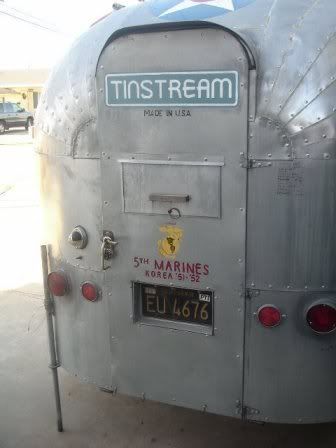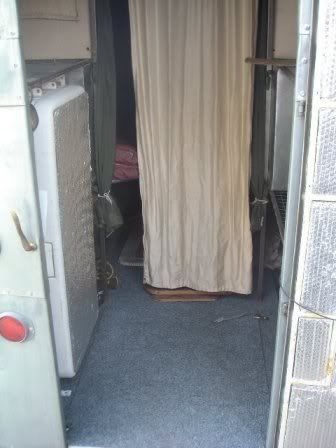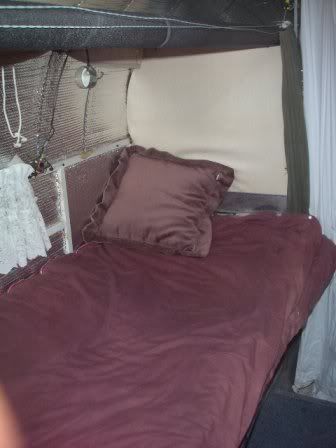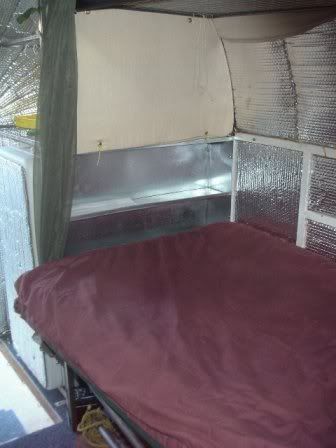John Cronin has kindly replied with lots of information, so here it is:
<quote>
For years my youngest son and I camped at Bluegrass Music Festivals using simple tents [we play a little guitar and banjo]. Our counterparts attended in big bucks motor homes and campers. We liked the simplicity of tent camping but the downside was a long setup and takedown period, so I decided to build a trailer.
I knew exactly what our needs were and I wanted to keep things simple. At every outing we would hear people's complaints about equipment failure; refrigerators, stoves, air conditioners, heaters, generators, TVs, etc. I wanted to avoid those problems, hence no hi tech equipment whatsoever (to fail) on my 'rig'. I also wanted to make it as small as possible for ease of towing. My only concession to modern gadgetry is interior electric lights and a couple outside plug ins at key stations.
I always admired the AIRSTREAMS of the '30's and that's what influenced the design. I wanted it to look 'old'. The most frequently asked question about it is, "What year is this?" My answer, "2004". Took eleven months to build.
As simple as it is, it has three features the most expensive models do not have. One is an outside auxiliary sink [located at top of storage box at front], a true luxury. The other is a 'no step up' rear entry at back door. When I arrive at campsite I remove a (2 foot) square floor panel which allows entry to the back of trailer, while still standing on the ground, without having to 'step up' into the trailer. From this point I can reach most of the things one goes 'into' the trailer for. Climbing 'up' into a trailer 100 times a day gets a little tiring. The little TEARDROP trailers are nice in that regard, no climbing steps. The third exclusive feature is that the trailer is symmetrical on the exterior. The roll up (for travel) awning can mount to either side as does the snap on outside cooking counter. The interior of the trailer is for sleeping, full bathroom, hot and cold food and equipment storage. All cooking and other activities are done outside. In foul weather the two bunk beds can fold up to allow dining, etc. inside.
When I read about restoration jobs the restorer invariably says, "I had to replace all the dry rotted wood." My framework is all steel. The only wood is a short section of flooring down the center, sealed with 'undercoating' on the bottom side. The frame rails are 2" square tubing (some 3/16 thick, some 1/4) reinforced at high stress points. Tongue members are 3" channel. Axle is 3" square tubing with (bolt on) spindles and wheels from a '63 Ford pick up truck. Tail lights from same truck. Leaf springs from a '52 Mercury. [If I ever build another, I will consider a torsion type axle/spring set up for a lower profile].
The hardest part was fabricating the 24 'banana peel' curved upper corners. I found out later there is a tool (English Wheel) that would have made things a little easier. The fasteners are self drilling/self taping #8 screws (not rivets). Oh, one other thing, the skin is .020 thick galvanized steel (not aluminum). The galvanized steel gives the exact 'aged' look I was looking for. Weighs less than 1500 pounds full up. Insulated with 1" fiberglass, covered with 3/8 inch aluminized 'bubble wrap'. Shower floor at front center has an 8" step down for added headroom at curvature of roof. [Step down floor can be seen in pic with Model 'A'].

Doing our thing; pickin' Bluegrass.
See:
* Awning for food prep counter.
* Food prep counter.
* Removable floor panel at rear door with mosquito blocking curtain deployed.
* 8" wind turbine on roof under 20 gallon water tank under solar heated four gallon hot water tank. [Tank is out of camera view].
* American, US Marine, & Bluegrass Club flags.
* Note the TINSTREAM logo. [So as not to be confused with that 'other trailer manufacturer'].

No wood to rot.
2" square tube frame.
1" square tube vertical members.
1" and 2" x 1/8 curved members.
3" channel tongue.
Valuable fabricating assets:
*Three casters tack welded to frame for ease of movement during fabrication.
*Two screw jacks tack welded in place to 'level & plumb' work during critical measurements.
*A small wire feed electric arc welder. [US made "Lincoln 125"]
*A hand powered hack saw. US made Milwaukee "Porta-Band".
<end quote>





 I'm going to be in serious trouble with the wife. There's no way I can finish my life on Earth without building one of these. (I'm 29 so I have some time). Lincoln Welder eehh?
I'm going to be in serious trouble with the wife. There's no way I can finish my life on Earth without building one of these. (I'm 29 so I have some time). Lincoln Welder eehh?





